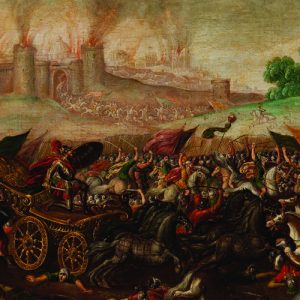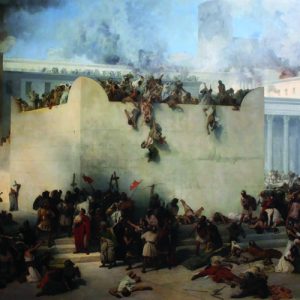×


We have detected your country as:
Please click here to go to the USA website or select another country from the dropdown list.
by: Ilse Posselt, BFP News Correspondent

Mourning at the Western Wall on Tisha B’Av (Photo: shlomi kakon/PikiWiki Israel/wikipedia.org)
The calendar in the Land of Promise is marked with days set aside to remember. Some are joyous, celebrating the triumphs, miracles and bravery on which Israel was built. Others are solemn, commemorating the tragedies, heartaches and sacrifices woven into the chronicles of the Jewish people.
Tisha B’Av—literally the 9th day of the biblical month, Av—falls in the latter category. Jewish tradition refers to Tisha B’Av as the saddest date on the calendar, a day known for devastation and disaster. It is a dramatic label, yet not altogether undeserved. Throughout the ages, terrible tragedies—including the destruction of both the First and Second Temples—have befallen the children of Israel on the 9th of Av.
This year, the saddest day on the Jewish calendar starts at dusk on the 13th of August. For the following 25-hour period from sunset to sunset, a hush will fall over the land as Israel fasts and mourns in remembrance of the calamities that have marred this day. Thousands will flock to the Kotel (Western Wall) to spend the day prostrated in prayer or reading from Lamentations in the shadow of the only remaining remnant of the Second Temple.
Rabbinic tradition teaches that the cycle of tragedy began more than 3,000 years ago, when a nation of former slaves stood on the edge of the wilderness, eager to enter the Land of their Promise. Yet first, God instructed Moses, “Send men to spy out the land of Canaan” (Num. 13:2).
Moses obeyed and dispatched 12 scouts on a reconnaissance mission. The spies, rabbis teach, returned to camp on the 8th of Av, reporting that the land was simply unconquerable. That night, on the 9th Av, the camp resounded with weeping Israelites who believed the Almighty had set them up for defeat. Angered by the people’s unbelief and the spies’ account, on Tisha B’Av God decreed that the original generation rescued from Egypt would never enter the Promised Land and subsequently the 9th of Av became a day of weeping and misfortune for all time.

Destruction of the First Temple 586 BC (Photo: Circle of Juan de la Corte/wikipedia.org)
For nearly two millennia, Tisha B’Av came and went without calamity. Yet disaster struck some 1,800 years later in 586 BC, when King Nebuchadnezzar, ruler of the mighty Babylonian empire, led his armies to the walls of Jerusalem. For 30 months, the ancient stones held firm. Then the Babylonian horde breached the walls and fell on the starving, plague-ridden city. Nebuchadnezzar’s men began the destruction of Jerusalem on the 7th of Av, tearing down the walls and setting fire to anything that would burn.
Two days later, the pillaging army reached the heart of the Jewish people—Solomon’s Temple. On the 9th of Av, as dusk approached, the First Temple was set alight and destroyed. The fire reportedly burned for 24 hours. When the smoke finally faded, nothing remained but smoldering rubble. The Temple was no more. Some 100,000 Jews had been slaughtered and millions led away into exile.
The destruction of the First Temple stands as one of the most terrible tragedies in Jewish history. Yet after 70 years of Babylonian captivity, Israel returned to Jerusalem to rebuild their shattered city and lives.
Five centuries later in AD 70, history all but repeated itself. This time, the pillaging army was Roman. But the war over Jerusalem was no less devastating. The final battle took place on the morning of the 9th of Av. When dusk fell, the Second Temple was engulfed in flames.
Once again, Jerusalem was reduced to nothing but smoldering rubble. All that remained of the Holy Sanctuary was the retaining wall on the western side of the Temple Mount. Some one million Israelites had been slaughtered—and the Jews would soon be scattered throughout the nations, exiled for nearly 2,000 years.
Twice in the history of the people of Israel, the Holy Temple beckoned from Mount Moriah as the heartbeat of life. And twice the center of the Jewish world was torn down—both times on the 9th of Av.

Destruction of Second Temple AD 70 (Photo: Francesco Hayez/wikipedia.org)
Following the destruction of the Second Temple, two more national tragedies befell the already reeling nation on Tisha B’Av. In AD 135, the 9th of Av marked Israel’s last stand against the Romans, its legions crushing the final pocket of Jewish resistance and slaughtering more than 100,000 people. A year later, again on the 9th of Av, the Romans ploughed up the site of the Temple and implemented its solution to erase all Jewish footprints from Jerusalem by building the pagan city, Aelia Capitolina—and barring access to Jews.
In the more than 2,000 years since, numerous other disasters have marked this date. On Tisha B’Av, the First Crusades were launched, resulting in tens of thousands of Jewish deaths. On the 9th of Av in 1290, Jews were expelled from England. In 1914, Germany entered World War I, which ultimately paved the way for World War II and the Holocaust. Moreover, on the 9th of Av, SS commander Heinrich Himmler received approval for the “Final Solution,” a death sentence for almost one third of the world’s Jewish population.
“Tisha B’Av,” a popular saying goes, “commemorates a list of catastrophes so severe it is clearly a day set aside by G‑d for suffering.” Over the past 3,000 years, the date has been synonymous with heartbreak, sorrow and destruction. Yet God is a God of restoration, of beauty for ashes and joy for mourning (Isa. 61:3).
That is why Israel holds fast to His promise found in Zechariah: “This is what the Lord Almighty says: ‘The fasts of the fourth, fifth [Av], seventh and tenth months will become joyful and glad occasions and happy festivals for Judah’” (Zech. 8:19 NIV).
All logos and trademarks in this site are property of their respective owner. All other materials are property of Bridges for Peace. Copyright © 2025.
Website Site Design by J-Town Internet Services Ltd. - Based in Jerusalem and Serving the World.